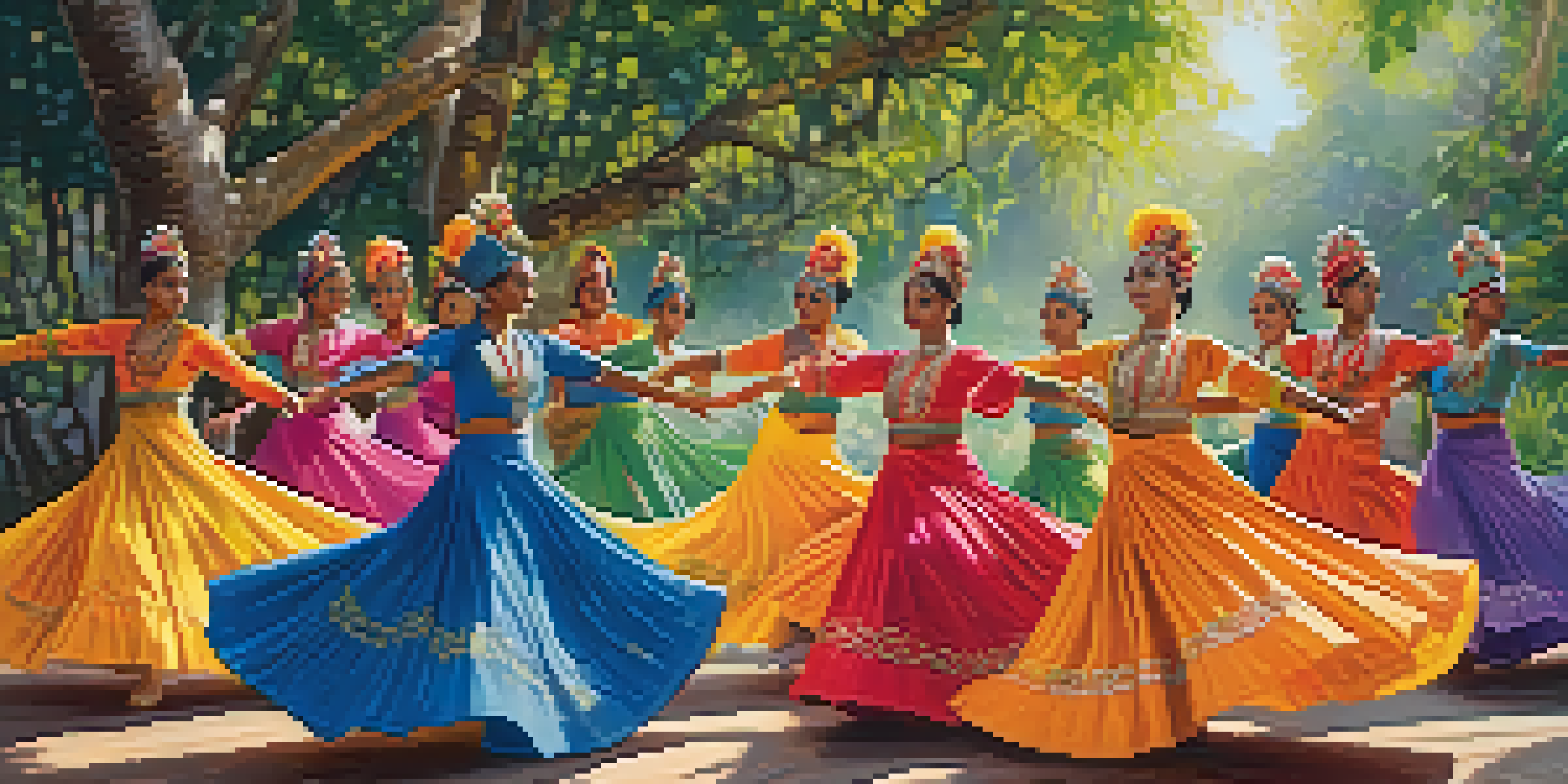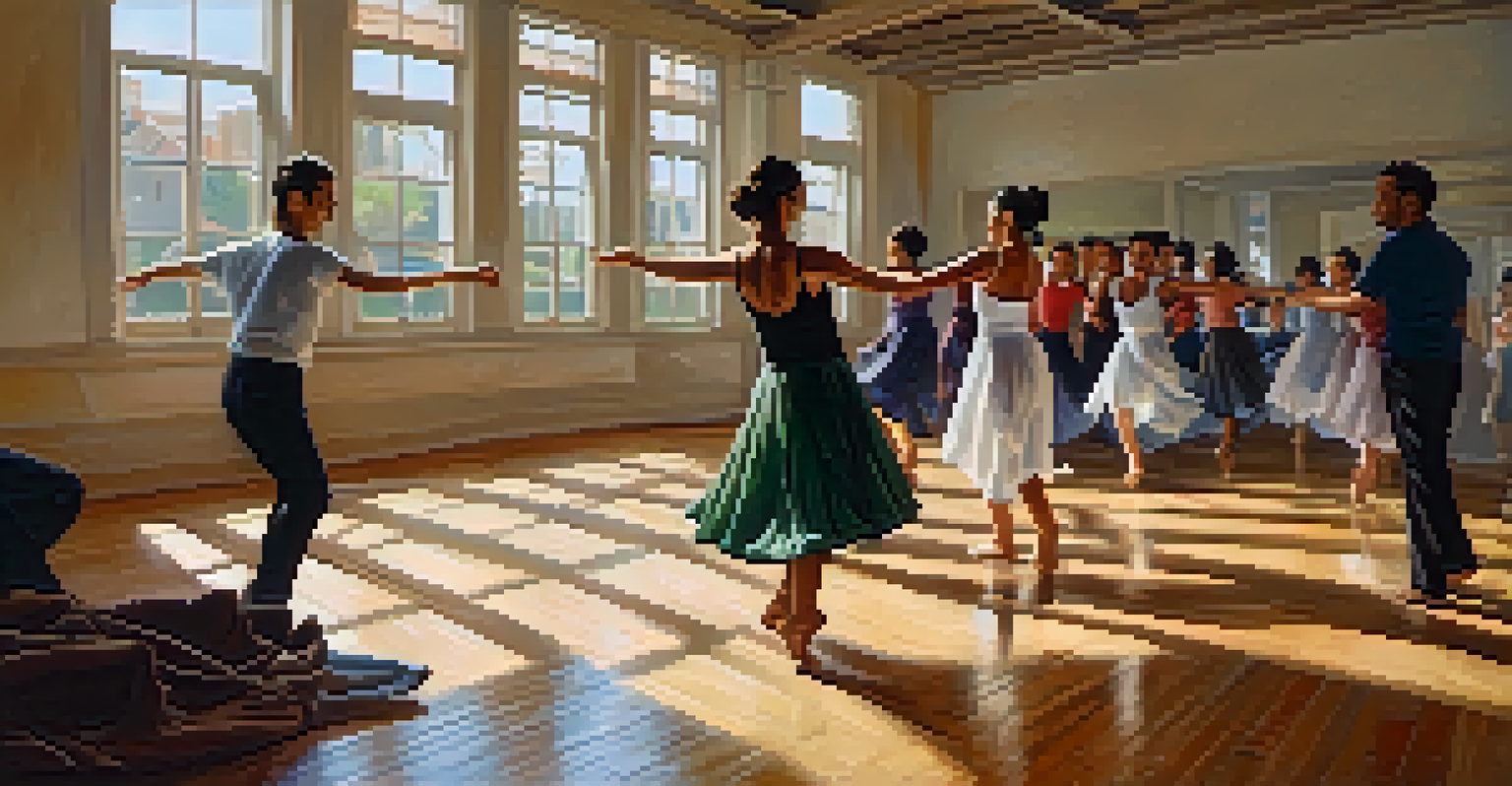Dance and Memory: How Movement Recollects Cultural Histories

The Interplay of Dance and Memory in Cultural Contexts
Dance is a powerful medium that transcends language, allowing people to express their emotions and stories through movement. This art form has been used throughout history to pass down cultural traditions, serving as a living archive of community experiences. As bodies move in rhythm, they create a narrative that connects generations, making memories tangible and accessible.
Dance is the hidden language of the soul.
For instance, traditional dances often embody significant historical events, rituals, or celebrations unique to a culture. Through these movements, dancers not only recall their ancestors but also educate audiences about their heritage. This interplay between dance and memory highlights how movement can serve as a bridge from the past to the present.
Moreover, dance provides a visceral experience that can evoke strong emotional responses, making it an effective tool for remembering. When individuals participate in or witness a dance, they may feel a sense of belonging and connection to their cultural roots, reinforcing the idea that memory is not just a mental exercise, but a bodily experience as well.
How Dance Acts as a Historical Record
Throughout history, dance has played a crucial role in documenting societal changes and historical narratives. For example, many Indigenous cultures have utilized dance to tell stories of creation, survival, and resistance. These performances become a form of oral history, where movements and rhythms encapsulate complex societal issues and events.

In contemporary settings, dance continues to serve as a record of cultural evolution. Choreographers often draw inspiration from historical events or social movements, using their art to comment on current issues. This creates a dialogue between the past and present, showing how cultural memories are not static but are continuously reinterpreted through dance.
Dance Preserves Cultural Memory
Through movement, dance acts as a living archive, connecting generations and allowing communities to express their cultural identities.
Furthermore, dance festivals and competitions often honor traditional forms while also encouraging innovation. This blend of old and new allows communities to celebrate their heritage while adapting to the changing world, ensuring that cultural histories remain alive and relevant.
The Role of Dance in Preserving Cultural Identity
Cultural identity is often expressed and preserved through dance, serving as a means of connecting individuals to their ancestry. For many communities, learning traditional dances is a rite of passage, instilling a sense of pride and belonging. This connection to movement fosters a deep understanding of one’s heritage, reinforcing cultural values and norms.
Dance is the joy of movement and the heart of life.
Take, for instance, the revival of folk dances or regional styles that may have been at risk of fading away. As communities come together to practice and perform these dances, they reaffirm their identity and pass on these traditions to younger generations. This preservation is vital for maintaining the essence of a culture, as dance becomes a living testament to its history.
Moreover, dance can also serve as a form of resistance against cultural erasure. By actively engaging in traditional movements, communities assert their existence and resilience in the face of globalization and homogenization. In this way, dance becomes both a celebration of cultural identity and a powerful tool for its preservation.
Embodied Memory: The Science Behind Movement and Recall
The connection between movement and memory is not just anecdotal; it has scientific backing. Research in neuroscience suggests that physical movement can enhance memory recall by engaging different parts of the brain. When we dance, our bodies become part of the memory-making process, reinforcing connections between physical gestures and emotional experiences.
For example, studies have shown that individuals with Alzheimer’s disease can often recall memories when they engage in dance or rhythmic activities. The act of moving can trigger emotional memories that may otherwise remain inaccessible. This phenomenon highlights how dance is not just an art form, but a therapeutic tool that taps into the deep wells of human memory.
Dance as Historical Record
Dance documents societal changes and historical narratives, serving as an oral history that encapsulates complex cultural issues.
Additionally, the practice of dance encourages mindfulness, as dancers focus on their movements and the music. This heightened awareness can improve cognitive functions and overall well-being, further linking the physicality of dance to memory retention. Thus, movement is not only a means of expression but also a pathway to deeper understanding and remembrance.
Community and Collective Memory Through Dance
Dance is inherently social, often performed in groups, which fosters a sense of community. This collective aspect of dance creates shared experiences that strengthen communal bonds and facilitate the sharing of cultural memories. When groups come together to dance, they embody a collective identity that transcends individual experiences.
For example, community gatherings that feature traditional dance often serve as opportunities for storytelling and sharing histories. Participants not only learn the steps but also the stories behind them, creating a rich tapestry of shared memory. This communal practice reinforces the idea that cultural histories are collectively owned and passed down through generations.
Moreover, dance can serve as a form of protest or social commentary, bringing communities together around shared values and experiences. When people unite to dance for a cause, they create a powerful statement that resonates with cultural memory and identity. This collective action highlights the role of dance in shaping and preserving social narratives.
Dance as a Medium for Intercultural Exchange
In our increasingly globalized world, dance serves as a bridge between cultures, facilitating intercultural exchange and understanding. Through collaborative performances and cross-cultural workshops, dancers from different backgrounds come together to share their stories and histories. This exchange enriches cultural memory, allowing individuals to draw parallels between their experiences.
For instance, fusion dance styles that incorporate elements from various traditions can create a dialogue about cultural identity and hybridity. These new forms of dance celebrate diversity while acknowledging the histories that inform them. By embracing different movements and rhythms, dancers can honor their own cultures while exploring the richness of others.
Collective Memory through Dance
Dance fosters a sense of community by creating shared experiences and reinforcing cultural identities among participants.
Additionally, international dance festivals often highlight the importance of cultural exchange. These events not only showcase diverse dance forms but also promote conversations about shared values and experiences. Through these interactions, cultural memories are not just preserved but also reimagined, fostering a deeper appreciation for the tapestry of human experience.
Conclusion: The Lasting Impact of Dance on Memory
In conclusion, the relationship between dance and memory is profound and multifaceted. Dance acts as a living archive, preserving cultural histories and allowing communities to express their identities through movement. As we explore this fascinating interplay, we recognize that dance is not just an art form but a vital means of connecting with our past.
As individuals and communities engage in dance, they create a shared narrative that transcends time and space. This collective memory fosters a sense of belonging and continuity, reinforcing the idea that we are all part of a larger story. By understanding the role of dance in this context, we can appreciate its power to evoke memories and emotions.

Ultimately, dance invites us to celebrate our cultural heritage while also embracing the ever-evolving nature of identity. As we move through life, let us remember the stories our bodies tell and the memories we create, ensuring that the dance of history continues for generations to come.